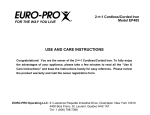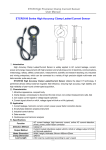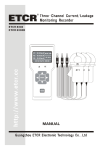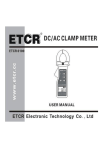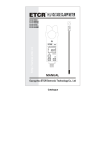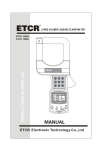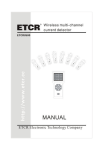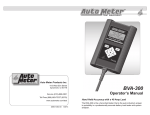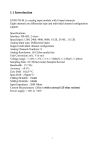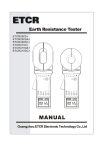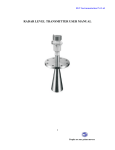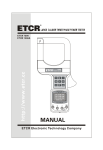Download ETCR9500_9500B user manual
Transcript
CONTENT Warning........................................................................................... 1 Ⅰ Introduction ............................................................................... 3 Ⅱ Electrical Symbols..................................................................... 4 Ⅲ Technical Specifications ............................................................ 5 Ⅳ Structure.................................................................................... 7 Ⅴ Operation .................................................................................. 7 1. Switch of high voltage detector ........................................... 8 2. Switch of main engine......................................................... 8 3. Detection on HV current...................................................... 9 4. Detection on LV current......................................................11 5. Transformation Ratio measurement ................................. 13 6. Data keeping and delete ................................................... 15 7. Data storage...................................................................... 15 8. Data search ....................................................................... 15 9. Data deletion ..................................................................... 16 Ⅵ Software .................................................................................. 16 1. Real-time monitoring page................................................ 17 2. Historical data page .......................................................... 17 Ⅶ Replace battery....................................................................... 18 Ⅷ Packing list .............................................................................. 19 Warning Thanks for purchasing Wireless HV Current Transformation Ratio Tester from our company. In order to have better use of this product, make sure that: ——Read this manual carefully; before conducting field tests, the operator shall fully understand guidelines in this manual ——Comply with safe rules and notices listed in this manual completely. u In any cases, safety shall come first when using this Tester, especially, in which the voltage circuit bears the voltage of AC 100V or more. u In case that the voltage circuit bearing the voltage over 600V is to be tested, the Tester shall be applied connecting insulating rod, with the hand holding on the fifth knot of it. u Due to risk of high voltage lines, operators shall have accepted rigid training and gained related certification for high voltage operation before conducting field test with this Tester. u Take notice of characters and symbols labeled on the face board and back board. u Please do not place or store the Tester under direct sunshine, in high temperature or moist places or places apt to be dewed. u Take notice of the polarities of the battery when doing replacement; remove the battery from the Tester if it is kept idle for a long time. u Disassembly and maintenance of this Tester shall be done by operators with authorization. u Please do not use Testers whose binding clips and other parts are broken. u Avoid attacking binding clips and maintain the Tester regularly. Soft cloth (e.g. glasses cloth), moistened by clean, antirust and dehumidified lubricant (e.g. WD-40), instead of corrosive agent or rough issues shall be used to gently rub down the Tester. u In case that continuing use will cause safety hazard due to the performance of the Tester itself, stop using it and mothball it at once, then leave it to authorized organization for handling. u When contacting the sign “ ” (dangerous), users shall follow the directions on the Tester and manual to do safe operation. u When contacting the sign “ ”(extremely dangerous) ,users shall rigidly follow the directions on the Tester and manual to do safe operation, u It is suggested to test the insulating strength for this Tester at least one time a year.( AC100kV/rms, section between the fifth knot of insulating rod) Ⅰ Introduction ETCR9500 Wireless HV Current Transformation Ratio Tester breaks through the traditional structure, specializing in on-line measurement of high-voltage current transformer in service under 60KV, primary and secondary current of transformers, transformation ratio, and leakage current(ETCR9500B also with phase, polar, ratio difference, angle difference Indication). It consists of high voltage detector, low-voltage secondary current clamp, main engine, high-voltage insulation rods. The wireless transmission signal is able to penetrate obstacles, such as walls of buildings. The signal’s direct-line transmission distance is about 30m. The HV/LV high accuracy clamp ammeter can be used to measure the current and leakage current varying from 0.01mA to 1000A.HV clamp ammeter can also measure LV current. Current clamp: In order to make sure of the high accuracy, stability and reliability during any monitoring at any time the entire year, special alloy is selected, and latest CT technology plus magnetic shield technology almost resistant to external magnetic field are adopted. Main engine: Gorgeous blue LCD presents you clear information at a glance and it possesses super large memory space capable of storing 3,000 sets of data. Monitoring Software: Functions such as real-time monitoring and historical data search is available, as well as curve drawing, ratio, max, min, average indication, alarm value setting .There are also functions such as data documents saving and historical report printing. High voltage detector: It connects five knots of insulation rods and applies in test of high/low-voltage lines bearing the voltage below 60KV; its dedicated high-voltage current clamp can easily clip or withdraw the lines to be tested by pressing down or unplugging back the insulation rod, which saves time and runs effectively; so, it is widely used for substation, power plant, power audit department, industrial and mining establishments as well as check station, electrician maintenance departments to conduct current detection, opposing electricity-stealing, outdoors electrical operation etc. The insulation rod is characterized by lightless, moisture protection, high temperature resistance, shock resistance, bending resistance, high insulation, flexibility and so on. ETCR9500 Wireless HV Current Transformation Ratio Tester is called Wireless Transformation Ratio Tester for high voltage; meanwhile it can function as high/low-voltage clip-on ammeter, for high-altitude current tester, high-altitude leakage current tester, clip-on leakage current meter with high accuracy and other products. Ⅱ Electrical Symbols Extremely dangerous! Operators shall rigidly follow the safe rules, or the potential electric shock will cause personal injury or death. Dangerous! Operators shall rigidly follow the safe rules, or the potential electric shock will cause personal injury or death. Warning! The safe rule shall be followed completely, or personal injury or damage to equipments will arise. Alternating current (AC) Direct current (DC) Ⅲ Technical Specifications Function Power source Test way Transmission way Display mode LCD dimension Tester size Clamp Dimension Sampling speed Measurement range Resolution Gearing Measuring accuracy of the primary circuit (23℃±3℃,below 80%RH) Measuring accuracy of the secondary circuit Transformation On-line testing for current, transformation ratio, and leakage current of primary/secondary circuit of high/low voltage current transformation; on-line testing for current and transformation ratio between two sides of the transformer (Phase, polar, ratio difference, angle difference indication is also available on ETCR9500B) DC6V alkaline dry battery(1.5V AAA×4) keeps a continuous work for 30 hours Clip-on CT Wireless transmission with direct-line transmission distance about 30m LCD: 128dots×64dots; Blue screen, backlight, suitable for dark places Display area: 44mm×27mm Width × Height× Thickness: Main engine: 75mm×170mm×30mm HV Current Clamp:76mm×255mm×31mm LC Current Clamp:175mm×70mm×38mm HV Current Clamp:φ48mm LC Current Clamp: φ25×30mm About 3 times/second High voltage detector: 0.1mA~1000A Low-voltage current clamp: 0.01mA~6A High voltage detector: 0.1mA Low-voltage current clamp: 0.01mA Automatic gearing 0.0mA~299mA: ±1%±3dgt 0.30A~49.9A: ±1.5%±5dgt 50.0A~199.9A: ±2%±5dgt 200A~600A: ±3%±5dgt 601A~1000A: ±4%±5dgt 0.00mA~6A: ±1%±3dgt (23℃±3℃,below 70%RH) Three kinds measurement of transformation ratios:( actual of primary/secondary circuit; ratio Data storage Line voltage Data hold Data search Overflow display No signal instruction Automatic shutdown Battery voltage Tester quality External interference Working temperature and humidity Storing temperature and humidity Insulation rod size Length of the lead of LV current clamp Insulation strength transformation on the basis of secondary circuit bearing current 5A; transformation on the basis of 10kV-YY of 10kV/380V transformer and the Max. ratio is 1:100 million (1.0K8) 3,000 sets, press HOLD to hold the data ,number and store automatically(power failure or battery replacement will not cause data missing) Test for lines bearing voltage below 60kv (insulating rods with five knots must be used) Press HOLD to hold the data, and sign of “Hold” appears; press it again, holding will be canceled. Press HOLD and POWER to enter the mode of data search. Outrange overflow: “OL A” appears When the main engine does not receive transmit signals, present “No Signals” 15 minutes after starting up, the tester will shutdown automatically When battery voltage is below 4.8v, sighs will remind you of replacement Main engine: about 240g (including battery) High voltage detector: about 335g (including battery) Low-voltage needle-point current clamp: about 190g Total weight: about 2.5kg(including insulation rod and battery) No super strong electromagnetic field; no same frequency interference of 433 MHz and 315 MHz -25℃~45℃; below 80%Rh -10℃~60℃; below 70%Rh φ32mm, 1m/know (standard configuration: five knots), extendable Standard: 2 meters (lengthen according to the on-site length) High voltage detector: AC100kV/rms(section between the fifth insulation rod and the clamp core of high-voltage current clamp) Structure Main engine and low-voltage current clamp: AC1000V/rms Antidrip II(high voltage detector) Ⅳ Structure ① ② ③ ①High voltage detector ②Main engine ③Low-voltage current clamp 1 High-voltage current clamp 2 LED power indication of HV detector 3 Power key 4 Joints of insulation rods 5 Input interface for low-voltage current 6 LCD monitor of the main engine 7 HOLD key 8 RS232 Interface 9 Output plug for low-voltage current clamp 10 Low-voltage current clamp Ⅴ Operation Before using the tester, examine whether there is any part broken; if no, it can be put into use. Install the battery according to the manual. 1. Switch of high voltage detector Press POWER to start the detector, and the POWER indicating light is on. The detector will begin to do automatic detection and send the result to the main engine by wireless transmission. If the indicating light keeps flickering about 15 minutes after the detector is started, this will present an automatic shutdown and after it keeps flickering for about 30 seconds, the detector will be shut down automatically to reduce battery consumption. During the flickering of the POWER indicting light , pressing POWER will make the detector continue to work. Press POWER will shut down it. 2. Switch of main engine Press POWER to start the engine, and LCD displays. After the normal startup, the main engine will enter test receiving mode(see the picture below). The primary current is the testing data of high-voltage terminal while the secondary current the low-voltage. In case that signals are detected in both primary and secondary circuits, the main engine will show the transformation ratios on the basis of secondary circuit bearing current 5A. If transformation ratio is too high, which means that the current value in the primary circuit is large while it in the secondary is small, the ratio surpasses 1000,000, i.e. “x.xxxK6”(x.xxx×106)is displayed, the numeral value behind “K” means the power of 10. Of course, this phenomenon will not occur in the normal operational circuit. In data search mode, press POWER key and shift the cursor to “return”, return to the test mode by pressing the HOLD key, power off by pressing the POWER key. 3. Detection on HV current High voltage, very dangerous!Nobody but a qualified personnel after training could conduct operation on it. The operator should obey safety regulations, otherwise there will be the danger of electric shock resulting in personal injury or casualty. Only when all of the five insulating bars are connected can the high voltage line be detected, otherwise there may be the danger of electric shock resulting in personal injury or casualty. Dangerous! It is not allowable to measure high voltage line above 60V, otherwise there will be danger of electric shock resulting in personal injury or casualty. Dangerous! It is not allowable to detect the high current wire above 1000A. Prior to the detection, have the insulation bars connected properly, finally have the detector connected, for avoidance of any ground impact on the instrument. Nothing but the special-made insulation bars could be connected to the instrument. After the detection, collect the insulation rod in slant direction, first take apart the detector, then the insulation bars for the avoidance of ground impact on detector High voltage detector is connected properly with 5 insulation rod and started normally .Set the detected wire at the center of guide sector on detector pliers head(Diagram A). High voltage detector has guide sector perpendicular to wire, Push forward the insulation rod, the wire detected is clamped by the high voltage detector which starts detection and feedback to the main set. Main set enter detection and data collection state after its normal starting up, If the main set receives the signal sent by the high voltage detector, there will be a live indication of current amount on high voltage end, If the main set fails to receive the signal sent by the high voltage detector, the first current is indicated to be” no signal” for the primary loop. If the main set has“OL”as its first currency indication, that means that the first current exceeds the upper limit of the high voltage detector. Push the insulation rod backward, the high voltage detector is disconnected with the wire.(As shown in Diagram C).Do make every effort to keep the guide sector perpendicular to wire upon withdrawing. Notice: For the sake of safety, please take the instrument away from the wire after the detection is finished. 4. Detection on LV current High voltage, very dangerous!Nobody but a qualified personnel after training can conduct operation on it. The operator should bear safety regulations in mind, otherwise there will be the danger of electric shock resulting in personal injury or casualty. Low voltage current pliers are not allowable to detect high voltage wire above 600V or 6A, otherwise there will be the danger of electric shock resulting in personal injury or casualty. 1)Connect low voltage current pliers and main set, turn the main set on, enter the detection mode. 2)Have low voltage current pliers clamp the wire(notice: it work holding jaws is fully closed),examine the current numerical reading, if the instrument has secondary current indication of “OL” ,the secondary current exceeds instrument upper current limit . 3)Reference illustrations Clamp electricity wire and zero wire at the same time, leakage current could be detected.(note: total 2 wires) Clamp the ground wire, the leakage current could be measured(note: single wire) Clamp the main line ,total current amount could be measured. (note: single wire) Where its numeral reading is not easily accessible, use high voltage detector to examine the current on low voltage wire. ⑴Examine if there is a leaker. ---First current no signal ---Secondary current 35.0MA ⑵Detect the equipments leaker ---First current no signal ---Secondary current 35.0MA ⑶Detect leaker of ground wire ---First current no signal ---Secondary current 35.0MA 5. Transformation Ratio measurement 【Primary current】: The current collected with high voltage current pliers is mutual inductor’s first current 【Secondary current】: The current collected with low voltage current pliers is mutual inductor’s secondary current. 【Ration based on secondary current 5A】 :The measured secondary current value is converted to be 5A,then convert the first current based on that ratio,the same transformation ratio. Display 【Ratio 】: The ratio between the first current and secondary current by actual measurement. 【 10kV-YYconversion ratio 】: high voltage detector collects the secondary bus current, The ratio between transformer’s first current and mutual inductor secondary current could be calculated by transformer 10kV/380V As above described, concerning high voltage detector and the first and secondary return circuit clamped by low voltage current pliers , the main set has an indication of the first and secondary current number and tranformation ratio,if the first current is 680A,the secondary current is 2.00A,its current ratio is 340.0, calculated based on the secondary loop circuit 5A,the transformation ratio is 1700/5A,(which is 5 ÷2×680),the 10kV/380V transform has a transformation ratio of 12.9, the first current to the secondary current of mutual inductor (which is 340÷(10kV÷380V) ) ① ①Detection display mode ② ②Conversion ratio display mode In detection mode, press the HOLD key for 3 seconds, enter the conversion display mode as shown above on the right diagram: the first, second loop current.10kV-YY conversion ratio. Press the HOLD key for 3 seconds, exit from the conversion ration display mode, return to the start-up detection mode. In the ratio conversion mode, click the HOLD key to set the second time currency base number, and conversion ratio is calculated, press the POWER key to shift the cursor. Press the HOLD key for 3 seconds, exit from the conversion ratio display mode,return to the start-up detection mode. Each time the instrument starts up with the secondary current 5A being the default conversion ratio. 6. Data keeping and delete In detection mode, press the HOLD key for LCD display of the HOLD symbol. Press the HOLD key to release the data lock, return to the detection mode, the “ HOLD ” symbol disappears. 7. Data storage In detection mode, press the HOLD key for data holding, the instrument will store the data and remind you the total stored data number. The instrument has a data storing capability of 3000 groups. If the stored data is full, there is a symbol indication of “ FULL ”, clear the memory for next data storage. 8. Data search In detection mode, press both the HOLD key +POWER key to enter the data search mode, meanwhile the detector will auto-display the group 0001 data. Now press the POWER key and shift the cursor, press the HOLD key to confirm. The instrument are designed with fast search function from“+1、-1、 +10、-10” stored data, press the HOLD key once, search in increased (reduced) order ,shift the cursor on “+10、-10” position, press the HOLD key, data number could be increased or reduced by 100,search and view the cycled data stored downward or upward. Shift the cursor to “ESC” the return position, press the HOLD key, exit from the data search mode, back to the detection mode. 9. Data deletion In data search mode, press the POWER key and shift the cursor to the “delete DEL”position, then press the HOLD key “YES”to delete all the stored data ,and return to detection mode,it is not possible to restore the data just being deleted. Ⅵ Software The Minitoring and data upload software have to be installed and run on the computer base on Windows XP/2000 OS. Monitoring Software: Functions such as real-time monitoring and historical data search is available, as well as curve drawing, ratio, max, min, average indication, alarm value setting .There are also functions such as data documents saving and historical report printing 1. Real-time monitoring page Red Curve indicates the primary current and green curve indicates the secondary. Curve zoom in and out: Click on the left key(no release) of the mouse and move the mouse. 2. Historical data page Historical data process:read,access,saving,analyse, Sequence,draw curve, print. Ⅶ Replace battery Caution! No detection could be conducted when the battery cover is not properly closed, otherwise there is danger. Pay attention to battery electrode, otherwise it will do harm to the instrument. 1. When high voltage detector has its battery voltage below 4.8V,its main set flashes with ---.When the main set has its battery voltage below 4.8V,the main set displays the low voltage icon, indicating that the battery is short of power, replace the battery. 2. Power off, confirm that the instrument is shutdown. Loosen the 2 screws on the battery cover, open the battery cover and replace with new qualified batteries. Paying special attention to the size and electrode, close the battery cover, tighten the two screws. 3. Press the POWER key to examine whether the instrument is normally stared up,if not ,re-operate according to step 2. Loosen it by turning the 2 screws counter clockwise Tighten it by turning the 2 screws clockwise Ⅷ Packing list High voltage detector 1 unit Main set 1 unit Low voltage current pliers 1 unit Insulation bar(1 M/pc) 5 pcs Instrument box 1 pc Manual/warranty card/certification 1 unit Manufactured by Guangzhou ETCR Electronic Technology Co., Ltd Address: B-3F, North Jixian Industrial Park, North Baiyun Avenue, Guangzhou Postcode:510440 Tel:086-20-36282512 36282505 Fax:086-20-36282515 Email:[email protected] Website:http://www.etcr.cc

























